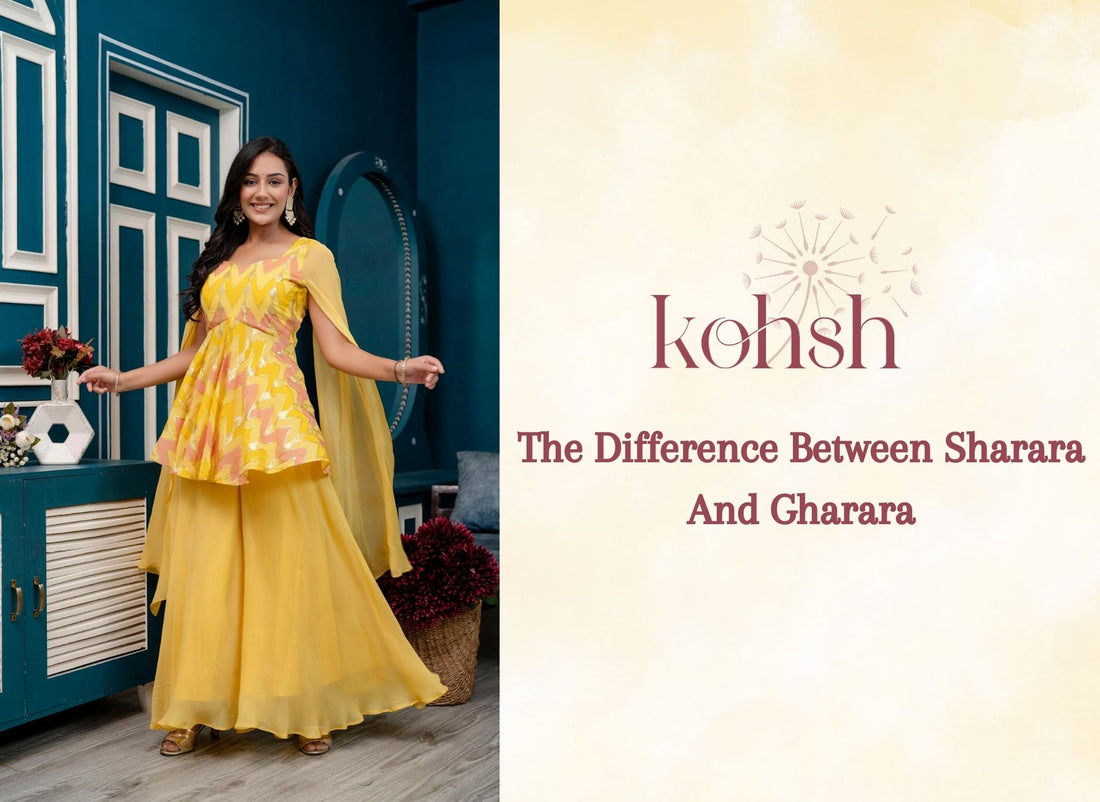Difference Between Sharara And Gharara
Feature |
Sharara |
Gharara |
|
Cut and Style: |
It typically features a flared silhouette with a straight cut and wide flare, resembling loose, flowing trousers. The flare starts from the knee or just below the knee. |
Gharara, on the other hand, has a more exaggerated flare. The flare in gharara starts from the knee or above, giving it a distinct and fuller look. |
|
Flare Pattern: |
The flare in a sharara is usually uniform, creating a flowing and graceful appearance. |
Gharara's flare is often divided into multiple panels or 'ghairas,' giving it a more tiered or layered look. |
|
Length of the Flare: |
The flare of a sharara is generally moderate, offering ease of movement and a more subtle appearance. |
Gharara has a more voluminous and dramatic flare, adding a touch of grandeur to the outfit. |
|
Pairing with Kurti or Kurta: |
It is often paired with a shorter kurti or kurta that falls just above or at the knee, highlighting the flare of the sharara. |
Gharara is traditionally paired with a longer kurti or kurta, sometimes even reaching mid-thigh or below, to complement its extravagant flare. |
|
Occasions: |
Shararas are considered suitable for both casual and formal occasions. The degree of embellishments and fabric used can determine the formality of the outfit. |
Ghararas are often associated with more festive and formal occasions like weddings and celebrations due to their elaborate design and regal appearance. |
|
Historical Context: |
Originating from Central Asia, the sharara has evolved over time and is known for its cultural diversity and adaptability. |
Gharara has its roots in traditional Mughal attire and has maintained its distinctive style over the years. |
In the rich tapestry of traditional Indian and Pakistani attire, the Sharara and Gharara stand out as timeless symbols of grace and femininity. While both are wide-legged trousers, they each carry a unique history, design, and cultural significance. In this detailed exploration, we unravel the intricate details that differentiate Sharara from Gharara, providing insights into their origins, styles, and the contemporary revival of these stunning ensembles.
The Origins of Sharara and Gharara
To understand the difference between Sharara and Gharara, one must delve into their historical roots. The Sharara finds its origins in the Mughal era, where it was a staple in royal courts. Characterized by its flared silhouette, the Sharara became synonymous with regality and opulence. On the other hand, the Gharara traces its roots to Awadh, with a design that evolved from the traditional shalwar. Ghararas are known for their unique divided leg pattern, giving them a distinct twirl and charm.
Sharara: A Regal Affair
The Sharara, with its flared trousers, is a manifestation of elegance and sophistication. Traditionally worn with a short kurti or a kurta and paired with a dupatta, the Sharara exudes grace and femininity. The wide flare of the trousers is often accentuated with intricate embroidery, zari work, or embellishments, making it a perfect choice for festive occasions and weddings. The Sharara has transcended time and continues to be a beloved choice for those seeking a regal yet contemporary look.
Gharara: Twirls of Tradition
Distinctive in its divided leg pattern, the Gharara boasts a unique silhouette that captivates with every twirl. Ghararas are characterized by the divided legs that start at the knee or below, creating a voluminous and swirling effect. The Gharara is often paired with short kurtis or kameez and adorned with intricate gota work, zardozi embroidery, or lace detailing. Known for its festive appeal, the Gharara is a cultural emblem that has endured generations.
Fabric and Embellishments
Both Sharara and Gharara exhibit a stunning array of fabrics and embellishments that add to their allure. Shararas often feature luxurious fabrics like silk, georgette, or brocade, adorned with intricate threadwork, sequins, and zari. Ghararas, on the other hand, embrace the use of vibrant and lightweight fabrics like chiffon or silk, with detailed embellishments such as gota patti, lace, or hand-embroidery. The choice of fabric and embellishments further accentuates the cultural and regional influences in their designs.
Styling Variations
While the Sharara and Gharara share a common origin, their styling variations offer a diverse range of choices for fashion enthusiasts. Shararas can be paired with long kurtas for a more traditional look or with short kurtis for a contemporary twist. Ghararas, with their unique leg division, offer a playful and feminine vibe, and they can be styled with short or medium-length kurtis to highlight the distinctive silhouette. The versatility of both ensembles allows for experimentation, catering to diverse preferences and occasions.
Contemporary Revival
In recent years, there has been a notable resurgence of interest in traditional attire, leading to the contemporary revival of both Sharara and Gharara. Fashion designers and enthusiasts alike have embraced these timeless ensembles, infusing modern elements while preserving their cultural essence. The fusion of traditional craftsmanship with contemporary designs has resulted in a fresh and dynamic interpretation of Sharara and Gharara, making them relevant and sought-after choices for weddings, celebrations, and festive gatherings.
Conclusion
In the realm of women's ethnic clothing, the Sharara and Gharara stand as iconic embodiments of cultural heritage and sartorial elegance. While the Sharara flaunts its flared trousers with regal allure, the Gharara enchants with its twirls and distinct leg division. Each holds a unique space in the hearts of those who appreciate the artistry and tradition embedded in their design. As we celebrate the rich cultural tapestry that encompasses these ensembles, let the choice between Sharara and Gharara be a reflection of personal style, cultural pride, and the enduring legacy of timeless fashion.


